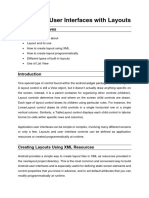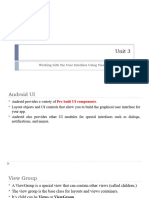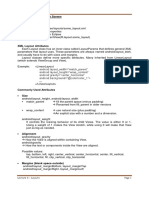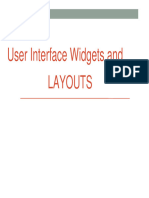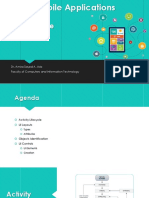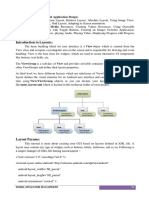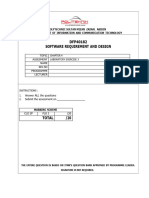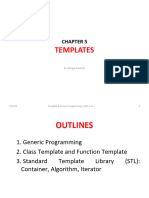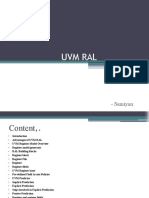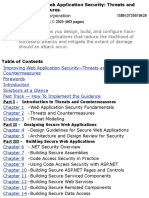Android Programming
LAYOUTS IN ANDROID
Android UI Layouts
Android Layout is used to define the user interface that holds
the UI controls or widgets that will appear on the screen of an
android application or activity screen.
Generally, every application is a combination of View and
ViewGroup.
As we know, an android application contains a large number of
activities and we can say each activity is one page of the
application.
Android UI Layouts
So, each activity contains multiple user interface
components and those components are the instances of the
View and ViewGroup.
All the elements in a layout are built using a View and
ViewGroup objects.
View
A View is defined as the user interface which is used to
create interactive UI components such as TextView,
ImageView, EditText, RadioButton, etc., and is
responsible for event handling and drawing.
They are Generally Called Widgets.
View
The Android framework will allow us to use UI elements
or widgets in two ways:
Use UI elements in the XML file
Create elements in the Kotlin file
ViewGroup
A ViewGroup act as a base class for layouts and layouts
parameters that hold other Views or ViewGroups and to
define the layout properties.
They are Generally Called layouts.
Types of Android Layout
Android Linear Layout
Android Relative Layout
Android Constraint Layout
Android Absolute Layout
Android Frame Layout
Android Table Layout
Android List View
Android Grid View
Different Attribute of the Layouts
android:layout_marginLeft
Used to declare the extra space used on the left side of View and ViewGroup
elements.
android:layout_marginRight
Used to declare the extra space used on the right side of View and ViewGroup
elements.
android:layout_marginTop
Used to declare the extra space used in the top side of View and ViewGroup
elements.
Different Attribute of the Layouts
android:id
Used to specify the id of the view.
android:layout_width
Used to declare the width of View and ViewGroup elements in the
layout.
android:layout_height
Used to declare the height of View and ViewGroup elements in the
layout.
Different Attribute of the Layouts
android:layout_marginBottom
Used to declare the extra space used in the bottom side of View
and ViewGroup elements.
android:layout_gravity
Used to define how child Views are positioned in the layout.
LinearLayout
LinearLayout is the most basic layout in android studio, that
aligns all the children sequentially either in a horizontal manner
or a vertical manner by specifying the android:orientation
attribute.
If one applies android:orientation=”vertical” then elements
will be arranged one after another in a vertical manner and If you
apply android:orientation=”horizontal” then elements will be
arranged one after another in a horizontal manner.
LinearLayout Attributes
android:id
This is the ID which uniquely identifies the layout.
android:baselineAligned
This must be a boolean value, either "true" or "false" and prevents the
layout from aligning its children's baselines.
android:baselineAlignedChildIndex
When a linear layout is part of another layout that is baseline aligned, it
can specify which of its children to baseline align.
LinearLayout Attributes
android:divider
This is drawable to use as a vertical divider between buttons. You use a
color value, in the form of "#rgb", "#argb", "#rrggbb", or "#aarrggbb".
android:gravity
This specifies how an object should position its content, on both the X
and Y axes. Possible values are top, bottom, left, right, center,
center_vertical, center_horizontal etc.
LinearLayout Attributes
android:orientation
This specifies the direction of arrangement and you will use
"horizontal" for a row, "vertical" for a column. The default is
horizontal.
android:weightSum
Sum up of child weight.
android:orientation= “vertical"
android:orientation= "horizontal"
RelativeLayout
Android RelativeLayout is a ViewGroup subclass, used to
specify the position of child View elements relative to each
other like (A to the right of B) or relative to the parent (fix
to the top of the parent).
Instead of using LinearLayout, we have to use
RelativeLayout to design the user interface and keep our
flat because it improves the performance of the application.
RelativeLayout Attributes
android:id
This is the ID which uniquely identifies the layout.
android:gravity
This specifies how an object should position its content, on both the X
and Y axes. Possible values are top, bottom, left, right, center,
center_vertical, center_horizontal etc.
android:ignoreGravity
This indicates what view should not be affected by gravity
Important Attributes for
positioning
layout_alignParentLeft
It is set “true” to match the left edge of view to the left edge of parent.
layout_alignParentRight
It is set “true” to match the right edge of view to the right edge of
parent.
layout_alignParentTop
It is set “true” to match the top edge of view to the top edge of parent.
layout_alignParentBottom
It is set “true” to match the bottom edge of view to the bottom edge of
parent.
Important Attributes for
positioning
layout_alignLeft
It accepts another sibling view id and align the view to the left of the
specified view id.
layout_alignRight
It accepts another sibling view id and align the view to the right of the
specified view id.
layout_alignStart
It accepts another sibling view id and align the view to start of the
specified view id.
layout_alignEnd
It accepts another sibling view id and align the view to end of specified
view id.
Important Attributes for
positioning
layout_centerInParent
When it is set “true”, the view will be aligned to the center of parent.
layout_centerHorizontal
When it is set “true”, the view will be horizontally centre aligned
within its parent.
layout_centerVertical
When it is set “true”, the view will be vertically centre aligned within
its parent.
res/values/strings.xml
ConstraintLayout
ConstraintLayout is a ViewGroup subclass, used to
specify the position of layout constraints for every child
View relative to other views present.
A ConstraintLayout is similar to a RelativeLayout, but
having more power.
Important Attributes of ConstraintLayout
android:id
This is used to give a unique id to the layout.
app:layout_constraintBottom_toBottomOf
This is used to constrain the view with respect to the bottom
position.
app:layout_constraintLeft_toLeftOf
This attribute is used to constrain the view with respect to the left
position.
Important Attributes of ConstraintLayout
app:layout_constraintRight_toRightOf
This attribute is used to constrain the view with respect to the
right position.
app:layout_constraintTop_toTopOf
This attribute is used to constrain the view with respect to the top
position.
Advantages of using ConstraintLayout
ConstraintLayout provides you the ability to completely design
your UI with the drag and drop feature provided by the Android
Studio design editor.
It helps to improve the UI performance over other layouts.
With the help of ConstraintLayout, we can control the group of
widgets through a single line of code.
With the help of ConstraintLayout, we can easily add animations to
the UI components which we used in our app.
Disadvantages
When we use the Constraint Layout in our app, the XML
code generated becomes a bit difficult to understand.
In most of the cases, the result obtain will not be the same
as we got to see in the design editor.
Sometimes we have to create a separate layout file for
handling the UI for the landscape mode.
FrameLayout
Frame Layout is designed to block out an area on the
screen to display a single item.
It is the simplest of the Layout Managers that pins each
child view within its frame.
By default the position is the top-left corner, though the
gravity attribute can be used to alter its locations.
FrameLayout
Generally, FrameLayout should be used to hold a single
child view, because it can be difficult to organize child
views in a way that's scalable to different screen sizes
without the children overlapping each other.
You can add multiple children stacks each new child on
top of the one before, with each new View potentially
obscuring the previous ones.
FrameLayout Attributes
android:foreground
This defines the drawable to draw over the content and possible values
may be a color value, in the form of "#rgb", "#argb", "#rrggbb", or
"#aarrggbb".
android:foregroundGravity
Defines the gravity to apply to the foreground drawable. The gravity
defaults to fill. Possible values are top, bottom, left, right, center,
center_vertical, center_horizontal etc.
FrameLayout Attributes
android:measureAllChildren
Determines whether to measure all children or just those in the
VISIBLE or INVISIBLE state when measuring. Defaults to false.
TableLayout
TableLayout is a ViewGroup subclass, used to display the
child View elements in rows and columns.
Each row has zero or more cells; each cell can hold one
View object.
TableLayout containers do not display border lines for
their rows, columns, or cells.
TableLayout Attributes
android:collapseColumns
This specifies the zero-based index of the columns to collapse. The column
indices must be separated by a comma: 1, 2, 5.
android:shrinkColumns
The zero-based index of the columns to shrink. The column indices must be
separated by a comma: 1, 2, 5.
android:stretchColumns
The zero-based index of the columns to stretch. The column indices must be
separated by a comma: 1, 2, 5.
Absolute Layout
An Absolute Layout lets you specify exact locations (x/y
coordinates) of its children.
Absolute layouts are less flexible
and harder to maintain than other
types of layouts without absolute
positioning.
Absolute Layout Attributes
android:id
This is the ID which uniquely identifies the layout.
android:layout_x
This specifies the x-coordinate of the view.
android:layout_y
This specifies the y-coordinate of the view.
GridView
GridView is a ViewGroup that is used to display a
scrollable list of items in a grid view of rows and
columns.
The Grid Layout is incredibly flexible and can be used to
greatly simplify layouts and reduce or eliminate the
complex nesting often required to construct UIs using the
layouts described before.
GridView
The grid items are not necessarily predetermined but they
automatically inserted to the layout using a ListAdapter.
“An adapter actually bridges between UI components
and the data source that fill data into UI Component.
Adapter can be used to supply the data to like spinner, list
view, grid view etc.”
GridView
The ListView and GridView are subclasses of
AdapterView and they can be populated by binding them
to an Adapter, which retrieves data from an external
source and creates a View that represents each data entry.
GridView Attributes
android:id
This is the ID which uniquely identifies the layout.
android:columnWidth
This specifies the fixed width for each column. This could be in px, dp,
sp, in, or mm.
android:gravity
Specifies the gravity within each cell. Possible values are top, bottom,
left, right, center, center_vertical, center_horizontal etc.
GridView Attributes
android:horizontalSpacing
Defines the default horizontal spacing between columns. This could be
in px, dp, sp, in, or mm.
android:numColumns
Defines how many columns to show. May be an integer value, such as
"100" or auto_fit which means display as many columns as possible to
fill the available space.
GridView Attributes
android:stretchMode
Defines how columns should stretch to fill the available empty space, if
any. This must be either of the values −
none − Stretching is disabled.
spacingWidth − The spacing between each column is stretched.
columnWidth − Each column is stretched equally.
spacingWidthUniform − The spacing between each column is
uniformly stretched..
GridView Attributes
android:verticalSpacing
Defines the default vertical spacing between rows. This could be in px,
dp, sp, in, or mm.
ListView
Android ListView is a view which groups several items
and display them in vertical scrollable list.
It used to display scrollable lists of items in a single
column.
The list items are automatically inserted to the list using
an Adapter that pulls content from a source such as an
array or database.
ListView
An adapter actually bridges between UI components and
the data source that fill data into UI Component.
Adapter holds the data and send the data to adapter view,
the view can takes the data from adapter view and shows
the data on different views like as spinner, list view, grid
view etc.
ListView Attributes
android:id
This is the ID which uniquely identifies the layout.
android:divider
This is drawable or color to draw between list items.
android:dividerHeight
This specifies height of the divider. This could be in px, dp, sp, in, or mm.
android:entries
Specifies the reference to an array resource that will populate the ListView.
ListView Attributes
android:footerDividersEnabled
When set to false, the ListView will not draw the divider before each
footer view. The default value is true.
android:headerDividersEnabled
When set to false, the ListView will not draw the divider after each
header view. The default value is true..












